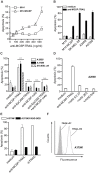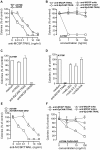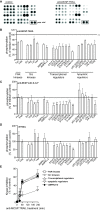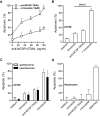Melanoma-associated Chondroitin Sulfate Proteoglycan (MCSP)-targeted delivery of soluble TRAIL potently inhibits melanoma outgrowth in vitro and in vivo
- PMID: 21092273
- PMCID: PMC3000402
- DOI: 10.1186/1476-4598-9-301
Melanoma-associated Chondroitin Sulfate Proteoglycan (MCSP)-targeted delivery of soluble TRAIL potently inhibits melanoma outgrowth in vitro and in vivo
Abstract
Background: Advanced melanoma is characterized by a pronounced resistance to therapy leading to a limited patient survival of ~6 - 9 months. Here, we report on a novel bifunctional therapeutic fusion protein, designated anti-MCSP:TRAIL, that is comprised of a melanoma-associated chondroitin sulfate proteoglycan (MCSP)-specific antibody fragment (scFv) fused to soluble human TRAIL. MCSP is a well-established target for melanoma immunotherapy and has recently been shown to provide important tumorigenic signals to melanoma cells. TRAIL is a highly promising tumoricidal cytokine with no or minimal toxicity towards normal cells. Anti-MCSP:TRAIL was designed to 1. selectively accrete at the cell surface of MCSP-positive melanoma cells and inhibit MCSP tumorigenic signaling and 2. activate apoptotic TRAIL-signaling.
Results: Treatment of a panel of MCSP-positive melanoma cell lines with anti-MCSP:TRAIL induced TRAIL-mediated apoptotic cell death within 16 h. Of note, treatment with anti-MCSP:sTRAIL was also characterized by a rapid dephosphorylation of key proteins, such as FAK, implicated in MCSP-mediated malignant behavior. Importantly, anti-MCSP:TRAIL treatment already inhibited anchorage-independent growth by 50% at low picomolar concentrations, whereas > 100 fold higher concentrations of non-targeted TRAIL failed to reduce colony formation. Daily i.v. treatment with a low dose of anti-MCSP:TRAIL (0.14 mg/kg) resulted in a significant growth retardation of established A375 M xenografts. Anti-MCSP:TRAIL activity was further synergized by co-treatment with rimcazole, a σ-ligand currently in clinical trials for the treatment of various cancers.
Conclusions: Anti-MCSP:TRAIL has promising pre-clinical anti-melanoma activity that appears to result from combined inhibition of tumorigenic MCSP-signaling and concordant activation of TRAIL-apoptotic signaling. Anti-MCSP:TRAIL alone, or in combination with rimcazole, may be of potential value for the treatment of malignant melanoma.
Figures






Similar articles
-
Turn TRAIL Into Better Anticancer Therapeutic Through TRAIL Fusion Proteins.Cancer Med. 2025 Jan;14(1):e70517. doi: 10.1002/cam4.70517. Cancer Med. 2025. PMID: 39740038 Free PMC article. Review.
-
Targeted delivery of a designed sTRAIL mutant results in superior apoptotic activity towards EGFR-positive tumor cells.J Mol Med (Berl). 2008 Aug;86(8):909-24. doi: 10.1007/s00109-008-0348-9. Epub 2008 May 27. J Mol Med (Berl). 2008. PMID: 18504532 Free PMC article.
-
A single chain immunotoxin, targeting the melanoma-associated chondroitin sulfate proteoglycan, is a potent inducer of apoptosis in cultured human melanoma cells.Melanoma Res. 2008 Apr;18(2):73-84. doi: 10.1097/CMR.0b013e3282f7c8f9. Melanoma Res. 2008. PMID: 18337643 Free PMC article.
-
Melanoma proteoglycan modifies gene expression to stimulate tumor cell motility, growth, and epithelial-to-mesenchymal transition.Cancer Res. 2009 Oct 1;69(19):7538-47. doi: 10.1158/0008-5472.CAN-08-4626. Epub 2009 Sep 8. Cancer Res. 2009. PMID: 19738072 Free PMC article.
-
Human high molecular weight-melanoma-associated antigen (HMW-MAA): a melanoma cell surface chondroitin sulfate proteoglycan (MSCP) with biological and clinical significance.Crit Rev Immunol. 2004;24(4):267-96. doi: 10.1615/critrevimmunol.v24.i4.40. Crit Rev Immunol. 2004. PMID: 15588226 Review.
Cited by
-
Stability and activity of MCSP-specific chimeric antigen receptors (CARs) depend on the scFv antigen-binding domain and the protein backbone.Cancer Immunol Immunother. 2015 Dec;64(12):1623-35. doi: 10.1007/s00262-015-1767-4. Epub 2015 Oct 29. Cancer Immunol Immunother. 2015. PMID: 26515978 Free PMC article.
-
Turn TRAIL Into Better Anticancer Therapeutic Through TRAIL Fusion Proteins.Cancer Med. 2025 Jan;14(1):e70517. doi: 10.1002/cam4.70517. Cancer Med. 2025. PMID: 39740038 Free PMC article. Review.
-
Apoptosis-Inducing TNF Superfamily Ligands for Cancer Therapy.Cancers (Basel). 2021 Mar 27;13(7):1543. doi: 10.3390/cancers13071543. Cancers (Basel). 2021. PMID: 33801589 Free PMC article. Review.
-
Targeted induction of apoptosis in glioblastoma multiforme cells by an MRP3-specific TRAIL fusion protein in vitro.Tumour Biol. 2014 Feb;35(2):1157-68. doi: 10.1007/s13277-013-1155-7. Epub 2013 Nov 26. Tumour Biol. 2014. PMID: 24272336
-
Molecular Mode of Action of TRAIL Receptor Agonists-Common Principles and Their Translational Exploitation.Cancers (Basel). 2019 Jul 7;11(7):954. doi: 10.3390/cancers11070954. Cancers (Basel). 2019. PMID: 31284696 Free PMC article. Review.
References
-
- Balch C, Buzaid A, Soong S, Atkins M, Cascinelli N, Coit D, Fleming I, Gershenwald J, Houghton A, Kirkwood J. et al.Final Version of the American Joint Committee on Cancer Staging System for Cutaneous Melanoma. J Clin Oncol. 2001;19:3635–3648. - PubMed
-
- Helmbach H, Sinha P, Schadendorf D. Human melanoma: drug resistance. Recent Results Cancer Res. 2003;161:93–110. - PubMed
-
- Campoli MR, Chang CC, Kageshita T, Wang X, McCarthy JB, Ferrone S. Human high molecular weight-melanoma-associated antigen (HMW-MAA): a melanoma cell surface chondroitin sulfate proteoglycan (MSCP) with biological and clinical significance 1. Crit Rev Immunol. 2004;24:267–296. doi: 10.1615/CritRevImmunol.v24.i4.40. - DOI - PubMed
Publication types
MeSH terms
Substances
LinkOut - more resources
Full Text Sources
Other Literature Sources
Medical
Miscellaneous

